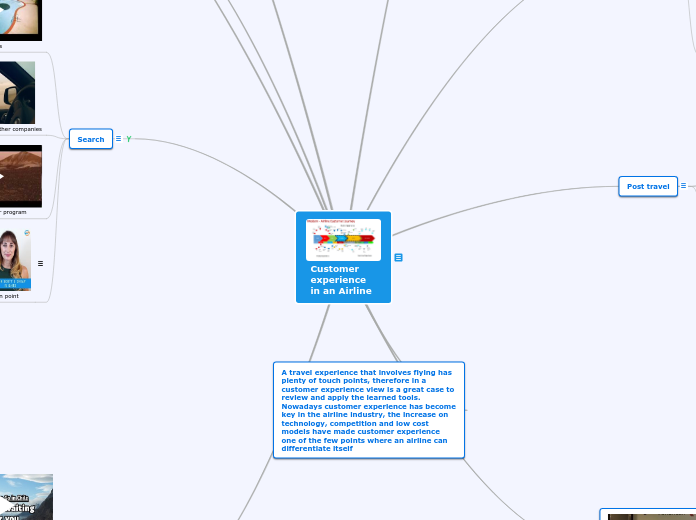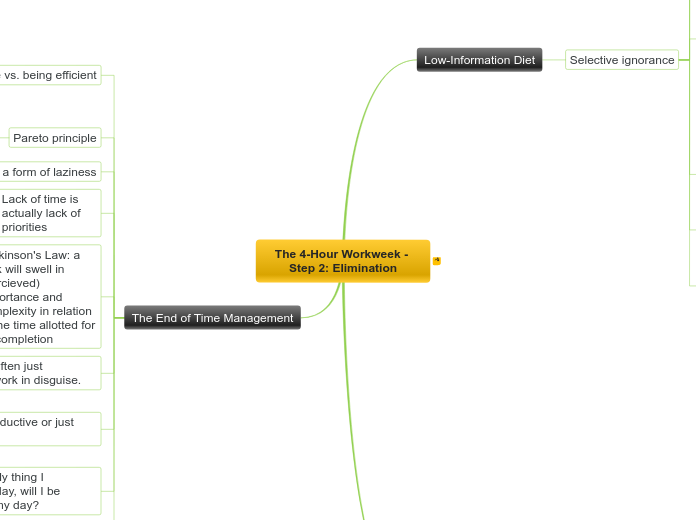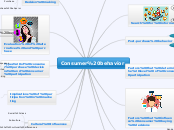av Cristián Rivas 6 år siden
196
Customer experience in an Airline

av Cristián Rivas 6 år siden
196

Mer som dette


Ved Jim Blodget


Ved Anthony Johnson


Ved Harrison Rodriguez


Ved Leyla Izaguirre
I'm going to use the customer journey to evaluate accurately all the points of the experience
Given that 12% of the flights have some sort of delay this the way to handle them is crucial for the airline customers experince and sinse they are related to waiting let analize from the 8 principles of waiting in lines, but adjusted to waiting in general
Unoccupied time feels longer than occupied: Is hard to maintain the passengers occupied during a delay, but in terms of designing experience is key to take care of families with kids. Maintain the kids busy (like painting or something) and at the same time with water. Other passengers tend to empathic with families during delays and not taking good care of them becomes a crisis.
Anxiety makes waits seem longer: In order to manage passengers anxiety is very important to maintain them informed. During a delay people is thinking about the plans that they have when reaching destination, connecting flights among other things, this increases anxiety. The airline needs to make sure that passengers understand what is going on and how they are going to take care of them.
Uncertain waits are longer than know: Same as before, information is key to make the waiting period as painless as possible, even if the staff doesn’t know when they are going to be able to board, they need to set a time for updates in the information.
Unexplained waits are longer that explained: Most of the delays are because the airline is ensuring the safety of the passengers, so when they have delays is important that they know that is for they own safety and that the airline is doing everything in its power to solve the problem as soon as possible.
Unfair waits are longer than equitable: In travelling this happens with bad weather conditions, different airlines have different protocols and while one airline might decide to fly their planes another can decide against it in the same weather conditions. Again, here is key to inform the passenger the reason for the delay in order to reduce anger and anxiety
Post travel.
In post travel the airlines need to give good reponses to client enquiries: lost luggage, damage luggage, problems with miles and rewards
If a client needs to contact the airline after flying is already a pain point, so customer service has to be as nice, effective and efficient as possible.
Today social networks are a huge tool for clients complains and also as a source for information.
It's really important that airlines monitor them and also use them as channels to answer to client requirements and problems
This has to be easy and fast to use, but more important than that, since you are interacting with a computer, is imperative that they give you estimates of how long they will take to answer you.
To not damage the experience any further the people in the call centres has to be able resolve your problems fast and with amiability. Giving them proper training es crucial for success
The landing process has 3 main touch points
Luggage claim: is touch point could be also related to waiting times and this could depend or not on the airline. The airline could not be fast enough to move the luggage from the airplane to the airport of security procedures can delay the delivery of the luggage
Disembarkation: Here is important to take care of the client experience by telling the passengers when to stand, otherwise they could end up waiting for several minutes to disembark. This, especially if there is traffic at the airport, sometimes the pilots need to wait for a space where to park and this could take several minutes.
Customs: Again, this could be a part of the travel experience with anxiety and other touch pointthat the airline cannot control. To design a better airline experience this could give something like a magazine to read while in line
Customs: Again, this could be a part of the travel experience with anxiety and other touch pointthat the airline cannot control. To design a better airline experience this could give something like a magazine to read while in line
Luggage claim: is touch point could be also related to waiting times and this could depend or not on the airline. The airline could not be fast enough to move the luggage from the airplane to the airport of security procedures can delay the delivery of the luggage
Pain point: The way to improve the experience here would be though the principles of waiting lines. They should ensure to inform estimated waiting times and explain any delays. Also, is worth mentioning that the airlines have to make as easy as possible to find the baggage belts in big airport
Disembarking: the problem that can occur here is traffic to park at the airport bringing waiting times to already tired passengers
Disembarkation: Here is important to take care of the client experience by telling the passengers when to stand, otherwise they could end up waiting for several minutes to disembark. This, especially if there is traffic at the airport, sometimes the pilots need to wait for a space where to park and this could take several minutes.
The is the key part of the customer journey, is the part of the journey where the client is most expose to the airline service and staff.
The touch points include cleanliness, pitch between seats, food, staff interactions, amenities, in flight entertainment, environment and pilot skills.
Here the key for a good experience is being emphatic with the customer, some of them like to sleep though dinner, some of them are with kids, some of the are working while flying, etc.
All these types of passengers have different needs that if the flight crew can recognize and help with them in a customize experience it would make a great in-flight experience.
There are other things that can be done related to senses, take care of smell, touch of the seat, minimize noise, food with a great test and finally and airplane the looks modern a clean really affect the experience.
Here as we see in Schmitt principles, we can see an airline that its obsessive about the details and they use this a differentiator.
In airlines there are 2 types of main customers, business traveller and leisure traveler.
Business traveller: 12% of travellers, but the bring 75% of the revenues
Leisure traveller: 88% of passengers and the need to be inspire, inspire to travel. This is done through marketing of different participants (governments, travel agencies, hotels, etc.)
Pain point: Here the pain point is related to choose the place between many options and the cost restriction that the travellers might have. Then, using the experience design models what is key to overcome this pain point would be selling a solution not a product. A solution that fits perfectly the need and expectations of the customer
There are a few start-ups trying to solve this problem, and give you the trips options that could better fit your interests, expectations and budget.
From XD the main elementos that they try to address are:
Sell a solution for a problem not a product
Innovate to create cutomer value
Develop deep ongoing customer insight
In this part of the journey the client compares many different options through diferrent channels in order to have the best possible trip
This is key because 20% of all bookings are done through OTAS (Online travel agencies).
To capture clients is key to be present in this portals.
On another hand frequent flyers programs are key for the experience, 40% of the revenues of airlines come from selling frequent flyers miles to banks and other companies (
)
Pain point: Is confusing for the client to be sure that he’s getting the best deal, there are too many traveling portals with many different airlines, routes or dates that you can take, so to be sure that you’re getting the best deal possible is sometimes very frustrating or very difficult.
Related to this google offers a solution that customer centric that solves this problem. Google flights, compares the main traveling portals and gives you all the information in an easy to review form.
In a XD point of view the key aspect of this service is selling a solution not a product
And by 5c's model they subjects in this service are effective communication and building trust with the customer
Purchase could be key for the experience, the payment options or the asociation to certain banks to give more payment options could be diference between flying or not.
In here, I will also consider promotions, with any service or product the feeling of seeizing an opportunity could be a strong motivator
Pain point: Her is very simple, the client always ends up think, Could I have gotten a better price? How can I ensure that I’m paying the best price possible? Again, a customer centric organization like google offers a solution to this. Given that is a great place to find and compare flights it also gives you the option of getting notifications to your email when flight prices change or get better. This way is easier to be sure that you got at the right time and right moment for your travel purchase
Given the 5c's model this solution is focus on
Building trust, you are going to get the best possible price
Coordination, "I'll let you know when your trip gets cheaper so you can buy it"
Mutual knowledge, "let me know what you want and I'll send you the best offers"
In this part of the journey stress is high, travellers are anxious, but at the same time worried about having problems in getting to the airport and missing their flights. This is the reason why many people get to the airport many hours prior departure.
The solution to this pain point we can see in advanced cities like Barcelona, if there is a train service to the airport is much easier to calculate the time that is going to take you to get there and this, without traffic. It also resolves the problem of finding parking at the airport.
In this section will cover all the instances prior getting in the air; GEtting to the airport, Check-in and boarding.
Here are two clear kinds of experience; checking baggage or not.
Checking baggage; To check baggage you are obbligated to have a much longer interctation. Here you have to wieght to luggage make sure that is under the allowed weight (otherwise you have to pay extra or get rid off some stuff).
Inside this the are two options, self bag drop or regular. In self bag drop you need to learn how to use all the machines and this does not ensure that people wont make lines. In regular bagdrop there is usually a line and also a time frame where you can drop your luggage
Waiting in line as a pain point: Waiting is always a pain point. In this case could be improve with to main things, informing the passenger an approximate time that he’s going to wait in line to reduce his anxiety. Another thing could be the solo waiting, in here allowing passengers to get into the lines with their family members could be a big help (this only in the case that this does not bring more waiting time for everyone else.
The you can occupy the time of the passenger, in check in’s there is information needed that the passenger could filled while in line (classic one is emergency contact and if you have all the visas necessary for the country that you will be visiting), this not only help the time go faster, but at the same time it helps to make the whole process faster.
Amiability, when the line is too long the key of the ability is in making it as fast as they can with more people, space or others, but in another hand when the lines are short is the perfect chance to talk with passengers add a wow factor, for example, of trip recommendations for the destination of the passenger
Another idea related to Schimitt principles could be celebrating passengers’ birthdays, the staff checking bags always reviews passport where find out if a passenger has its birthday that day is not difficult. After identifying birthdays, they could call the crew and make something small, but special on board.
Finally, when it comes to waiting technology could be a great friend, especially if it easy to use, this es the case of self check in’s with even baggage check in that are made to make to airport experience at check-in less painful.
Here the main point in XD is using innovation to create more value for the customer, an automatization that's going to save time and hazzle
Security and customs is a part of the experience that can not be controlled by the airlines and it could be a big pain point between the waiting times and the amability of the personel
Pain point: Waiting, anxiety, fear, this is a pain point that could be related to many feelings. Since the airline doesn't controlled it what they can do to be more client centric and offer a more complete solution is giving destination or airport tips (like routes to get to your plane) in the form of a pamphlet or magazine so their travellers can have something to do during security (that doesn’t allow cell phones)
Its interesting here that even though is not the airlines problem, sinse is part of the customer journey the cannot avoid take charge.
They should keep innovating to create more value for passengers
General pain points
Since not every airline has the same boarding process this could be very confusing for the traveller.
The traveller might end up standing for long periods of time in line or not even in line, just waiting for his group to be called
This could be even worse in when is remote boarding. In these types of boarding the passengers need to take a bus to the airplane in order to board it. The bus could be uncomfortable, but if the weather conditions are extreme this could be an even bigger pain point.
Also, it could be traffic to take-off, which can cause a pain point to the customers by making them wait inside the airplane.
To design a better experience the key here could be related to staff, making a less painful experience with some humour or amiability, this could be a huge wow for the experience.
In reference to the 10 Schimtt principles this cannot be random, if is going to be a differenciator it needs to be standar, it needs to be planned